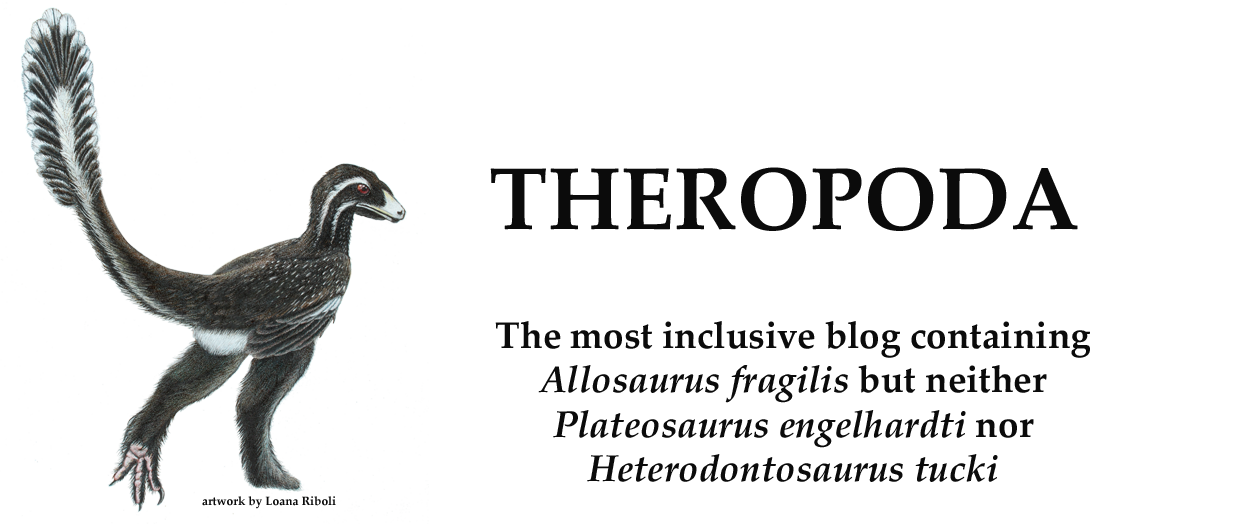I theropodi dell'Australia stanno rivivendo una seconda giovinezza. Ciò è un'ottima notizia, considerando la relativa frammentarietà dei resti, e le ipotesi contrastanti sulle loro affinità filogenetiche e paleogeografiche. In una recentissima revisione dei dinosauri australiani, Agnolin et al. (2010) rivalutano buona parte del materiale enigmatico raccolto nell'ultimo secolo.
Rivediamo i casi più interessanti.
- Walgettosuchus woodwardi, basato solamente su una vertebra caudale distale priva di caratteri diagnostici, è attribuito solamente a Theropoda indet.
- Il così detto "Allosaurus nano", basato su un astragalo, è reinterpretato come Abelisauroidea indet.
Precedentemente, questo esemplare era stato interpretato come un probabile Neovenatoridae, simile a Fukuiraptor e Australovenator. Agnolin et al. (2010) contestano questa attribuzione e identificano una serie di caratteri condivisi con Abelisauroidea: 1) un processo ascendente rettangolare e non trapezoidale, 2) un solco verticale sulla superficie caudale del processo ascendente, 3) un solco laterale verticale del processo ascendente, 4) un processo ascendente caudale dell'astragalo. Tuttavia, a parte il carattere 1), gli altri sono presenti anche negli allosauroidi (il 2 è noto in Mapusaurus e Fukuiraptor, il 3 in Fukuiraptor, il 4 in Allosaurus, Sinraptor, Mapusaurus). Pertanto, io non escluderei automaticamente un possibile status neovenatoride per questo esemplare. Attendo di aver immesso tutti i dati in megamatrice prima di esprimermi.
- Kakuru è interpretato come un Averostra di incerta posizione sistematica, ma comunque diagnostico. Un carattere che pareva avvalorare uno status coeluride o abelisauroide, la presenza di una cresta laterale distale della faccetta craniale della tibia, è risultato in realtà una frattura del fossile.
- Rapator risulta un Megaraptora. Questa ipotesi mi fa molto piacere, dato che io la esposi nel dettaglio proprio in questo blog un anno e mezzo fa.
- Timimus risulterebbe un Paraves simile a Unenlagiinae. Questa interessante ipotesi, argomentata nel dettaglio, merita di essere testata. A breve includerò nella mia analisi i caratteri citati in questo studio.
Altri esemplari sono descritti nello studio, ma non mi dilungo in proposito.
In conclusione, lo studio di Agnolin et al. (2010) mostra che buona parte dei taxa australiani identificabili sono riconducibili a linee prettamente gondwaniane (Unenlagiinae, Abelisauroidea, Megaraptora), e che il maggior grado di affinità è con le faune antartiche e sudamericane. Ciò è concorda con la paleogeografia cretacica e smentisce l'idea che l'Australia fosse una sorta di "rifugio" cretacico per taxa giurassici laurasiatici.
Ringrazio Lukas Panzarin per avermi inviato una copia di questo studio.
Bibliografia:
Agnolin, Ezcurra, Pais and Salisbury, 2010. A reappraisal of the
Cretaceous non-avian dinosaur faunas from Australia and New Zealand:
Evidence for their Gondwanan affinities. Journal of Systematic
Palaeontology. 8(2), 257-300.


A lot of Agnolin et al is basically super-taxonomic assignment: Dromaeosauridae, etc. In some cases, they miss precise opportunities to perform more daring statements:
RispondiEliminaQantassaurus, Atlascopcosaurus etc may actually forma gradational relationship, if not a clade, with the SA "gasparinisaurs." I will certainly be alluding to this in my take on the subject.
Agnolin et al. missed the discovery of Haplocheirus and this the supported details between Nqwebasaurus (dismissed out of hand) and Haplocheirus can permit Rapator both a MCI identity, and an alvarezsaur assignment. We'll see what happens. There is a diagnostic connection with the deeply incised prozximal MCI for the position of the first distal carpal when it comes to megaraptorans, which is cool, but unmentioned by Agnolin et al.
I was actually interested in your perspective on Walgettosuchus, given your work on Kemkemia.
The authors focused on several clades ending in -idae to make their deepest assignments, which more finer nomenclature available (e.g., Unenlagiinae). I wonder why.
Walgettosuchus seems a very distal caudal, based on joined pre- and postzygapophyes, narrow neural arch and neural spine absent.
RispondiEliminaReduction of the neural arch width, absence of a robust neural spine and apparent presence of relatively robust prezygapophyseal base are symplesiomorphic for theropod distal caudals: I see no evidence for a relationship with Kemkemia (or any other theropod clade).
How about the New Zealand dinosaurs?
RispondiEliminaThe New Zealand dinosaurs are isolated and fragmemtary remains from the Campanian-Maastrichtian: a mid-sized ornithopod ilium and several theropod fragments (most phalanges).
RispondiEliminaAndrea, aside from its position in the series, Walgettosuchus shares one thing with Kemkemi: They are both distal caudals used to support nomenclature. Would you as easily support the identity for Walgettosuchus as for Kemkemia. The lformer was originally treated as a crocodilian caudal, before being referred to Theropoda, but it's been regarded as an indeterminate theropod by every paper reveiwing it since, with the exception of being occasionally an indeterminate coelurosaur.
RispondiEliminaThe two specimens are a bit different.
RispondiEliminaBased on what is visible in the original description, Walgettosuchus lacks autapomorphies or an autapomorphic combination of features: it cannot be used for erecting a new taxon. It belonges to an indeterminate non-therizinosaurid, non-oviraptorosaur, non-pygostylian theropod.
The holotype of Kemkemia shows at least one autapomorphy and also an autapomorphic combination of features: being different from any other theropod distal caudal so far described can be used as holotype of a new taxon.
The statement in the article that putative Australian ceratopsids could be ankylosaurs or any kind of genasaurian ornithischians seems very suggestive. Even Minmi as close to ankylosaurids instead of nodosaurids seems to be a good start for new findings at Australia, maybe you will find entirely new clades there.
RispondiElimina